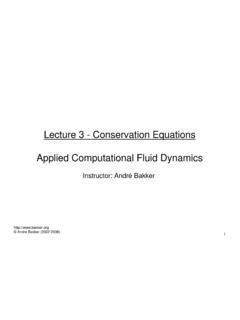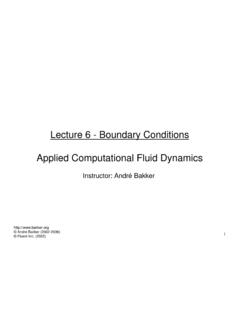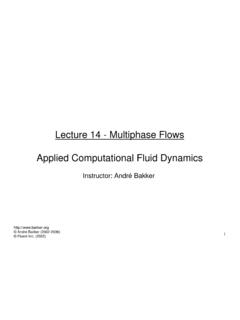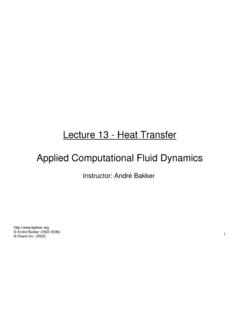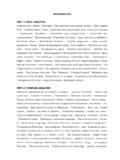Transcription of Lecture 10 - Turbulence Models Applied …
1 1 Lecture 10 - Turbulence ModelsApplied Computational Fluid DynamicsInstructor: Andr Andr Bakker (2002-2006) Fluent Inc. (2002)2 Turbulence Models A Turbulence model is a computational procedure to close the system of mean flowequations. For most engineering applications it is unnecessary to resolve the details of the turbulent fluctuations. Turbulence Models allow the calculation of the mean flow withoutfirst calculating the full time-dependent flow field. We only need to know how Turbulence affected the mean flow. In particular we need expressions for the Reynolds stresses. For a Turbulence model to be useful it: must have wide applicability, be accurate, simple, and economical to Turbulence Models Classical Models . Based on Reynolds Averaged navier -Stokes (RANS) equations (time averaged): 1.
2 Zero equation model: mixing length model. 2. One equation model: Spalart-Almaras. 3. Two equation Models : k- style Models (standard, RNG, realizable), k- model, and ASM. 4. Seven equation model: Reynolds stress model. The number of equations denotes the number of additional PDEs that are being solved. Large eddy simulation. Based on space-filtered equations . Time dependent calculations are performed. Large eddies are explicitly calculated. For small eddies, their effect on the flow pattern is taken into account with a subgrid model of which many styles are Methodsl = l/ReL3/4 Direct numerical simulation (DNS) Large eddy simulation (LES)Reynolds averaged navier -Stokes equations (RANS)5 Boussinesq hypothesis Many Turbulence Models are based upon the Boussinesq hypothesis. It was experimentally observed that Turbulence decays unless there is shear in isothermal incompressible flows.
3 Turbulence was found to increase as the mean rate of deformationincreases. Boussinesq proposed in 1877 that the Reynolds stresses could be linked to the mean rate of deformation. Using the suffix notation where i, j, and k denote the x-, y-, and z-directions respectively, viscous stresses are given by: Similarly, link Reynolds stresses to the mean rate of deformation: + ==ijjiijijxuxue + = =ijjitjiijxUxUuu ''6 Turbulent viscosity A new quantity appears: the turbulent viscosity t. Its unit is the same as that of the molecular viscosity: It is also called the eddy viscosity. We can also define a kinematic turbulent viscosity: t= t/ . Its unit is m2/s. The turbulent viscosity is not homogeneous, it varies in space. It is, however, assumed to be isotropic. It is the same in all directions.
4 This assumption is valid for many flows, but not for all ( flows with strong separation or swirl). + = =ijjitjiijxUxUuu ''7 The turbulent viscosity is used to close the momentum equations . We can use a similar assumption for the turbulent fluctuation terms that appear in the scalar transport equations . For a scalar property (t) = + (t): Here tis the turbulent diffusivity. The turbulent diffusivity is calculated from the turbulent viscosity, using a model constant called the turbulent Schmidt number (AKA Prandtl number) t: Experiments have shown that the turbulent Schmidt number is nearly constant with typical values between and = '' Turbulent Schmidt numberttt = 8 Flow around a cylinder The flow is stable for Reynolds numbers below ~40. For higher Reynolds numbers the flow is unstable.
5 This animation shows the flow pattern for Re = average streamlines (kg/s) - Re = 100010 Effective viscosity (kg/m-s) - Re =100011 These animations show the flow pattern as a function of Reynolds animations show the flow pattern as a function of Reynolds animations show the flow pattern as a function of Reynolds animations show the flow pattern as a function of Reynolds animations show the flow pattern as a function of Reynolds animations show the flow pattern as a function of Reynolds the turbulent viscosity The following Models can be used to predict the turbulent viscosity: Mixing length model. Spalart-Allmaras model. Standard k- model. k- RNG model. Realizable k- model. k- model. We will discuss these one by length model On dimensional grounds one can express the kinematic turbulent viscosity as the product of a velocity scale and a length scale: If we then assume that the velocity scale is proportional to thelength scale and the gradients in the velocity (shear rate, which has dimension 1/s):we can derive Prandtl s (1925) mixing length model: Algebraic expressions exist for the mixing length for simple 2-D flows, such as pipe and channel flow.
6 ()/()/(2msmsmtl yU l yUmt =2l 19 Mixing length model discussion Advantages: Easy to implement. Fast calculation times. Good predictions for simple flows where experimental correlations for the mixing length exist. Disadvantages: Completely incapable of describing flows where the turbulent length scale varies: anything with separation or circulation. Only calculates mean flow properties and turbulent shear stress. Use: Sometimes used for simple external aero flows. Pretty much completely ignored in commercial CFD programs today. Much better Models are one-equation model Solves a single conservation equation (PDE) for the turbulent viscosity: This conservation equation contains convective and diffusive transport terms, as well as expressions for the production and dissipation of t. Developed for use in unstructured codes in the aerospace industry.)
7 Economical and accurate for: Attached wall-bounded flows. Flows with mild separation and recirculation. Weak for: Massively separated flows. Free shear flows. Decaying Turbulence . Because of its relatively narrow use we will not discuss this model in k- model The k- model focuses on the mechanisms that affect the turbulent kinetic energy (per unit mass) k. The instantaneous kinetic energy k(t)of a turbulent flow is the sum of mean kinetic energy K and turbulent kinetic energy k: is the dissipation rate of k. If kand are known, we can model the turbulent viscosity as: We now need equations for kand .kKtkwvukWVUK+=++=++= )('''2222122221 22/32/1kkkt= l22 Mean flow kinetic energy K The equation for the mean kinetic energy is as follows: Here Eijis the mean rate of deformation tensor.
8 This equation can be read as: (I) the rate of change of K, plus (II) transport of K by convection, equals (III) transport of K by pressure, plus (IV) transport of K by viscous stresses, plus (V) transport of K by Reynolds stresses, minus (VI) rate of dissipation of K, minus (VII) Turbulence production.()()( ))()()()()()().''(.2''2)(VIIVIVIVIIIIIIE uuEEuuEPdivKdivtKijjiijijjiij + =+ UUUU23 Turbulent kinetic energy k The equation for the turbulent kinetic energy kis as follows: Here eij is fluctuating component of rate of deformation tensor. This equation can be read as: (I) the rate of change of k, plus (II) transport of kby convection, equals (III) transport of kby pressure, plus (IV) transport of kby viscous stresses, plus (V) transport of kby Reynolds stresses, minus (VI) rate of dissipation of k, plus (VII) Turbulence production.
9 ()()( ))()()()()()().''(''.2'''.''2'')(21 VIIVIVIVIIIIIIE uueeuuuepdivkdivtkijjiijijjiiij + + =+ uuU24 Model equation for k The equation for kcontains additional turbulent fluctuation terms, that are unknown. Again using the Boussinesq assumption, these fluctuation terms can be linked to the mean flow. The following (simplified) model equation for kis commonly used. The Prandtl number kconnects the diffusivity of kto the eddy viscosity. Typically a value of is used. + =+ )()(URate of increase ConvectivetransportRate ofproductionDiffusive transportRate ofdestruction25 Turbulent dissipation The equations look quite similar. However, the kequation mainly contains primed quantities, indicating that changes in kare mainly governed by turbulent interactions. Furthermore, term (VII) is equal in both equations .
10 But it is actually negative in the K equation (destruction) and positive in the kequation: energy transfers from the mean flow to the Turbulence . The viscous dissipation term (VI) in the kequationdescribes the dissipation ofkbecause of the work done by the smallest eddies against the viscous stresses. We can now define the rate of dissipation per unit mass as:''.2ijijee ''.2ijijee =26 Dissipation rate - analytical equation The analytical equation for is shown below. Because of the many unknown higher order terms, this equation can not be solved, and simplified model equations need to be A model equation for is derived by multiplying the kequation by ( /k) and introducing model constants. The following (simplified) model equation for is commonly used. The Prandtl number connects the diffusivity of to the eddy viscosity.

